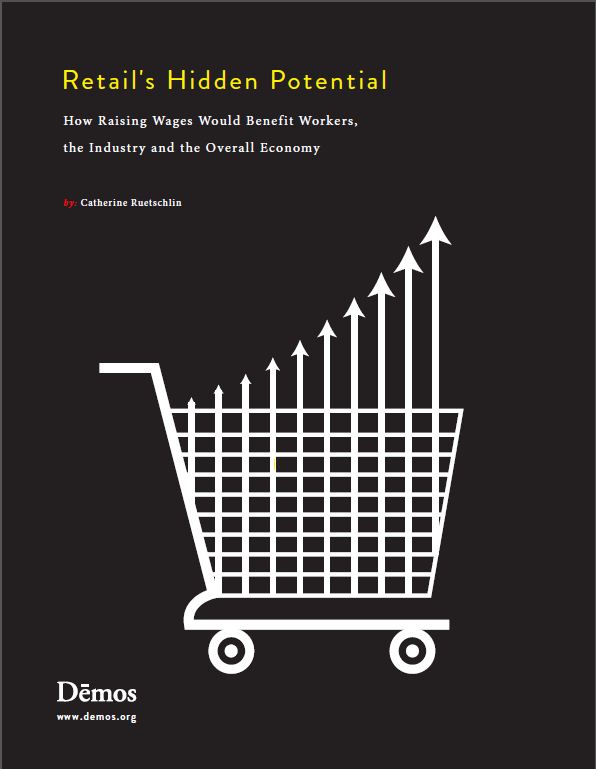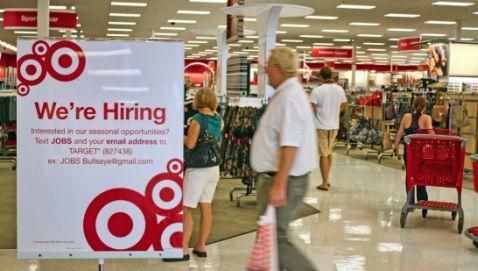A new study demonstrates big retailers could provide the nation a needed economic boost by paying higher wages – all while remaining profitable and continuing to offer low prices.

Retail’s Hidden Potential: How Raising Wages Would Benefit Workers, the Industry and the Overall Economy [PDF]
For the typical worker earning less than this threshold, the new floor would mean a 27 percent pay raise. But it would also yield a host of other benefits, as these highlights from their report show:
A decline in poverty: More than 700,000 Americans would be lifted out of poverty, and more than 1.5 million retail workers and their families would move up from in or near poverty.
Retail jobs are a crucial source of income for the families of workers in the sector, yet currently more than 1 million retail workers and their family members live in or near poverty.More than 95 percent of year-round employees at large retail firms are ages 20 and above. More than half (54.2 percent) of workers in this group contribute at least 50 percent of their family’s total income. A large number of them – almost 1 in 5 – are the sole earner for their family. The study finds:
- A wage standard equivalent to $25,000 for a full-time, year-round employee would lift 734,075 people currently in poverty – including retail workers and the families they support – above the federal poverty line.
- An additional 769,191 people hovering just above poverty would see their incomes rise to above 150 percent of the poverty line.

Mounting evidence shows that an industry-wide increase in retail wages would reduce poverty, improve economic growth, job creation and sales, with little effect on companies’ bottom line or consumer prices.
Improved economic growth and job creation: The economy would grow and 100,000 or more new jobs would be created. Families living in or near poverty spend close to 100 percent of their income just to meet their basic needs, so when they receive an extra dollar in pay, they spend it on goods or services that were out of reach before. This ongoing unmet need makes low-income households more likely to spend new earnings immediately – channeling any addition to their income right back into the economy, creating growth and jobs. This “multiplier effect” means that a higher wage standard for retail workers will also generate new jobs.
Estimates of the job creation effect are derived from widely accepted multipliers on consumer spending. It includes the benefits of a raise on disposable income and accounts for the impact of any additional costs to the firm and the potential for businesses to pass-through the cost of decent wages onto their customers through higher prices. In order to account for uncertainty regarding the firm’s willingness to pay for the raise out of profits, Demos provides both low and high measures of the total impact of the raise. Estimating both low- and high-end estimates, Demos finds:
- A wage standard at large retailers equivalent to $25,000 per year for full-time, year-round workers would increase GDP between $11.8 and $15.2 billion over the next year.
- As a result of the economic growth from a wage increase, employers would create 100,000 to 132,000 additional jobs.
Increased retail sales: Increased purchasing power of low-wage workers would generate $4 to $5 billion in additional annual sales for the sector. Much of the increased consumer spending by low-wage workers after the raise will return to the very firms that offered the raise. The average American household allocates 20 percent of their total expenditures toward retail goods, but for low-income households that proportion is higher. A raise for workers at large stores would bring billions of dollars in added retail spending back to the sector. The results:
- Assuming that workers do not save money out of their wage income, the additional retail spending by employees and their families generated by the higher wage would result in $4 to $5 billion in additional sales across the retail sector in the year following the wage increase.
Small effects on companies: The additional payroll costs would represent a tiny fraction (about 1%) of the $2.17 trillion in total sales by large retailers. Put another way, it represents 6 percent of payroll for the retail sector overall, or 10 percent for those firms with more than 1000 employees.
Demos measures the total cost of the higher wage standard with generous assumptions by accounting for the likely effects of wages on those workers currently earning just above the wage floor. They assume that every worker earning less than $17.25 will receive additional compensation as firms adjust pay scales in order to preserve their internal wage structures or to reward workers with long tenures or supervisory positions. That assumption probably overstates the indirect cost of raising wages at the bottom, since it extends to workers earning well above the cutoff for spillover effects that have been observed in empirical research. Yet the cost of the increase under these assumptions is just a small percentage of payroll or sales.
Little effect on prices: The potential cost to consumers would be just cents more per shopping trip on average. If retail firms were to pass the entire cost on to consumers instead of paying for it by redirecting unproductive profits, shoppers would see prices increase by only 1 percent.
However, productivity gains and new consumer spending associated with the raise make it unlikely that stores will need to generate 100 percent of the cost. More plausibly, prices will increase by less than the total amount of the wage bill, spreading smaller costs across the entire population of consumers. The impact of rising prices on household budgets will be negligible, while the economic benefits of higher wages for low paid retail workers will be significant. The study finds that:
- If retailers pass half of the costs of a wage raise onto their customers, the average household would pay just 15 cents more per shopping trip—or $17.73 per year.
- If firms pass on 25 percent of the wage costs onto their customers, shoppers would spend just 7 cents more per shopping trip, or $8.87 per year.
- Higher income households, who spend more, would absorb a larger share of the cost. Per shopping trip, high income households would spend 18 cents more, for a total of $36.80 per year. Low-income households would spend just 12 additional cents on their shopping list, or $24.87 per year.
More To Read
April 17, 2024
2023-24 Impact and Gratitude Report
Reflecting on a year of progress and transition at EOI
April 12, 2024
Welcoming our New Executive Director, Rian Watt!
EOI is excited to begin its next chapter under new leadership
April 4, 2024
Is There a Valid Argument Against Cost-Free College in Washington?
Cost-free college is a meaningful investment that would change lives. What's stopping Washington from making it happen?
